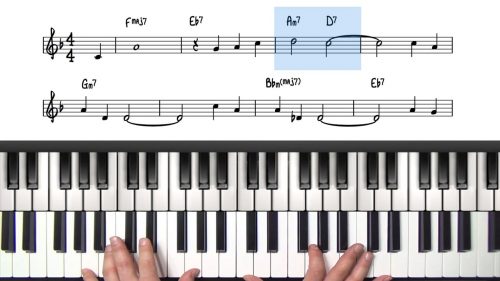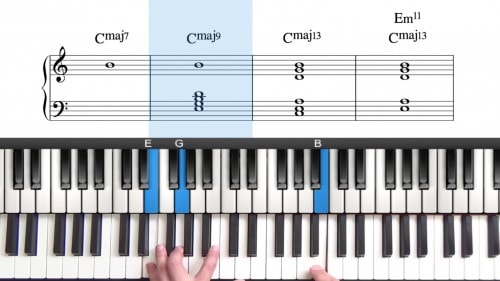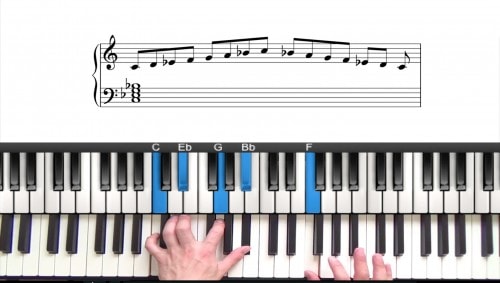So What Chord Voicing Tutorial
The ‘So What’ chord is a quartal chord voicing which means it is made of a stack of perfect fourth intervals. Unlike a pure quartal voicing, the So What chord has a major third interval on top.
Introduced by the pianist Bill Evans, the ‘So What’ chord is a modern sounding voicing that sounds great when you have a minor chord with the 5th in the melody.
Harmonic Ambiguity
The So What chord voicings has many different uses. It’s great for moving in parallel and to rehmonise chord changes. This is because stacked 4ths are harmonically ambiguous which gives you a certain degree of freedom to impose the voicing over different harmonies.
In this lesson, we explore the construction of the voicing and then apply it to a number of well known jazz standards.
Lesson Downloads
-
So What Chords Transcript & Notes File Type: pdf
-
So What Voicing 12 Keys File Type: pdf
Practice Tips
-
Learn the So What Chord in all 12 keys as directed in the practice drills.
-
When playing jazz standards, look out for minor chords with the 5th in the melody. This voicing will be a perfect fit.
-
It's useful to take the voicing around the circle of 5ths and also choose keys at random to make sure you are familiar with the voicing shape in all 12 keys.









Love this lesson. Can’t believe I am just watching this one. Thanks again.
Hi Adam, yes this is one of the earlier lessons I created… glad it’s still useful to members. Here’s a PDF of the So What Chords which should help you learn and memorise them in all 12 keys: pianogroove.com/wp-content/uploads/2016/09/so_what_chords_12_keys.pdf Cheers, Hayden
So much practicality in the reharmonizations and half step movements. Great stuff!
Cheers Adam!… Enjoy playing with this… you can get some really cool sounds with this voicing. When I see the 5th in the melody over a minor chord, my hands automatically gravitate towards the So What Voicing. Sometimes it can sound very ‘angular’ (due to the stacked 4ths) in which case just raise the 11th in your left hand to the 5th and it will sound less jarring – depends on the context, listen to your ears! Cheers, Hayden.
Hello Hayden, every video has english subtitles? I don´t speak english, but i like your course.
Hi There, sorry for the late reply, this comment slipped past me! I am currently working on adding subtitles… this should be finished in 2 months or so. I will keep you posted. Thanks, Hayden
Thank you Hayden, this is very useful. I really enjoyed how you harmonised the arpeggiated melody ! And thanks also for your generosity in providing the worksheets. Cheers.
That’s great Natasha… glad you enjoyed the lesson! No problem… if I can help you with anything else just fire me an email. Cheers.
It would have been a good time to show some examples of pure stacks of 4ths of other variants of so-what chords. For example, is the melody note is a b7, you can make sort of an upside so-what chord. Taking C-7 as an examples, you could use Eb-G-C-F-Bb, where you have a major 3rd on the bottom and then a stack of 4ths above it.
Again great example Fred… thanks for sharing!
If you’re interested in exploring other types of quartal voicings, check out this lesson on pentatonic harmony: pianogroove.com/jazz-piano-lessons/pentatonic-harmony-chords/
In that lesson we derive 5 quartal voicings from the pentatonic scale and explore how they can be used over a number of different chord types and qualities. This is an advanced topic and requires a lot of ‘heavy lifting’ to become familiar with the shapes and sounds.
Once you have practiced this stuff you will gain a lot of harmonic freedom as you can use these voicings in many different places.
Cheers,
Hayden
It also occurs to me to mention that often times chords in jazz can be ambiguous and it is really the context and what the bass player is doing that determines what it is. Take the so-what chord of a C-7, C-F-Bb-Eb-G. That chord is also an Eb MAJ with 9 and 13 added.
Hi Fred, yes that’s exactly right. If you are accompanying a vocalist or an instrumentalist … 4th voicings are always a good choice because the harmonic ambiguity gives a lot of freedom to the soloist. Great example with C so what = Emaj13.
I have a lesson in progress that gives examples of these voicings in context of major and minor 251s. We use quartal stacks for the II and I chords and then altered dominant for the V chord. It will be ready in couple weeks.
Cheers,
Hayden
Isn’t this song “My Foolish Heart”? It’s OK. I really want to learn that song too.
Sky
Hi Schuyler… yes that’s right, it is “My Foolish Heart” you can find the full lesson for that tune here: pianogroove.com/jazz-piano-lessons/my-foolish-heart-tutorial/ Cheers, Hayden
Hello. Nice video. On So What Chord Voicing score – All 12 Keys,
at the last bar, Gm11, on the bass clef, is written a F, it must be G.
Hey Ioannis… Thanks for spotting the inaccuracy… I have corrected the file :-)
Whilst the notation can help in the very early stages… try to move away from the notation as soon as possible and start to ‘visualise’ the notes on the keyboard.
It’s important to understand the formula for these voicings… that’s what I stress in the lesson. All you need to remember is Root and 11th in the left hand, and then b7, b3 and 5 in the right hand. That works in every key. every time!
Cheers,
Hayden
Great lesson, great chord! It just seem to be a bug with the video player functionality: I dont get the merits for finishing that lesson so I don’t get the checkmark in my Lessons overview… :-( Even though I repeated the lesson 3 times. Probably I am still playing too bad for getting the credits… ;-)
Hi Claudio,
Great… I’m glad you enjoyed the lesson!
Thanks for letting me know about the lesson completion notification… I am investigating the issue.
In the meantime, you can manually check and uncheck the tick boxes on the lesson overview page. I will get the automatic check off fixed asap.
And if you finish the lesson, you certainly deserve the credits! :-)
Cheers,
Hayden
Sorry, if I had known, that i can set the checkbox manually, i won‘t have bothered you. Thanks for that hint :-)
No problem Claudio… thanks for letting me know… I will create a video explaining how it works for new students :-) Cheers, Hayden
Hayden: very beautiful the chords and your lesson – but for me it would be very important if you put this lesson also in PDF – like the voices you used from Herbie and Kenny Voicings . Thanks !
Sorry ! It was my fault – I was not logged !
No problem Anthony… that was the questions I was going to ask you :-)
To see all lesson downloads, you must be logged in.
Cheers,
Hayden
hey thanks for the details, it makes a lots easlier to learn and practice, I believe the practice tips are useful.
One question, does so what voicing only work on minor chord, as it can approach a 4th movement?
Great jazz piano site!
I’ve seen many, but this is one of my favourites from now on.
A question about practicing. I know how to build the”so what” chord progression in any key with a combination of my ear and a knowledge of the intervals, so is it necessary to practice them the way you suggest? Rather, If i decide to use the so what chord in a song, can i not just wait to practice the so what chord within the context of the song im playing? Excellent lessons by the way, im really finally starting to understand the fundamentals that have mystified me my whole life!
I find that thinking of this as a 1 4 7 3 5 voicing enables me to see it faster. So, I think 5th of some minor 7th and then the 1 4 7 3 ….. I am already on the 5th (melody note).
Hi Hayden. This is my first post on the website. I am really getting a lot out of your courses so far.
I’m wondering why in the “My Foolish Heart” example, on the first instance of the Dm7 chord, why the So What chord cannot be applied first with the G on top (C-F-Bb-Eb-G) and then “side slip” into 5th of the Dm7 chord (D-G-C-F-A). Or is this also okay? Your example started with the A in the top voicing and then changing the melody note to go to a Bb and then back to the A. If one starts with the G on top like I described above, what is happening theoretically with the reharmonization and is it even possible to do? Is this like diatonic planing as opposed to chromatic side-slipping? Thanks for the help! And if there are any other lessons on planing, side slipping, diatonic and chromatic and modal parallel moving of voices to help straighten it all of those similar topics out, I’d love if you could point me towards them!
My favourite part is when you said, “So what’s the best way to practice the So What Voicing?”
Thanks Leon.
Believe it or not, that was unintentional 😄
Stay safe and enjoy the lessons!
Cheers,
Hayden
Hi Hayden. At Bar 4, when doing the reharmonisation, you said it’s Fm, Aflat minor and C minor so what chord. When go to last bar, you said the reharmonisation should be A flat, C and E flat so what. Please advis e why the forth bar have been called minor, but last bar not.
Hi SZE KING KA,
Good question!
That is just an abbreviation.
If I say “C Minor So What Chord” or “C So What Chord”, I am referring to the same thing.
The So What Chord is a minor voicing, and so by saying it is a So What Chord, it is known that it is minor.
I do appreciate that it could be a little confusing that I used 2 different names, but just remember that the So What Voicing is a minor chord voicing.
Hope this helps and any other questions let me know.
Cheers,
Hayden
Hi Hayden,
I am writing to ask about the reharmonization section. What is the logic behind the resolution from C so what chord to A7? And also, could you please explain the logic behind the movements such as from F so what – Ab so what – C so what.
Thank you,
Timothy
Hi Timothy 👋🏻
Good question!
We can use So What Chords to reharmonise a melody line. When we do this, we take the melody line and build a so what chord under each melody note so that the melody stays intact.
First to answer you question on “the logic behind movements such as F so what, Ab so what, and C so what:
When we move the exact same voicing shape around the keyboard, it always sounds pleasing. This is becuase our ears hear the exact same voicing and chord colour (minor 11), but in different places on the piano. An analogy here is like a poem which rhymes, the similarity in sound makes it flow smoothly. We are also keeping the melody intact and so we hear that melody ring out above the voicings which keeps arguably the most important aspect of the song intact – the melody.
Onto your next question about the resolution from C so what to A7…
So What Chords, and other quartal voicings, are harmonically ambiguous. When we build voicings from 4ths they have a very tense and angular sound which gives us more freedom on how we can resolve. Sometimes it’s hard to exlpain why something sounds pleasing to the ears, and this is an example of that because C-7 to A7 is not a conventional harmonic cadence or resolution, but because we have just strung together 3 unrelated minor chords to reharmonise the melody, we have created a lot of tension and so when we hit that A7sus it releases some of the tension we have just built up.
We have another lesson here which you might find insightful on reharmonising melody lines: pianogroove.com/jazz-piano-lessons/harmonising-step-wise-melodies/
I think you will find that lesson useful.
I hope the above helps and have fun studying this stuff.
Cheers,
Hayden
Hi Hayden,
Thank you very much for the explanation, now I understand it better. I have just 2 more clarifying question: When you say there is a pleasing sound in the voicings built from melodies, does this apply to others such as Kenny Barron or Herbie Hancock too? And should this technique be played before a chord change in the lead sheet?
Thank you,
Timothy
Hi Timothy,
Good questions.
For your first question, yes we can apply this technique with any voicing shape but it does work particularly well with voicing built from 4ths, and the So What voicing.
For the second question, when we apply this technique, we are ‘reharmonising’ the chords which means we are changing the chords from the original harmony on the lead sheet. It can be applied anywhere – before, during, or after a chord change.
Reharmonisation is quite a big topic and we have a full course on it here: pianogroove.com/jazz-piano-lessons/chord-substitution-reharmonisation/
This is one of our intermediate courses but by all means get stuck into the lessons. If some of the topics don’t make sense right now don’t worry about it as the full understanding will come with time, especially once we have applied the concepts in context of the jazz standards.
I hope this helps Tim and let me know if I can be of further assistance.
Cheers,
Hayden
Hi Hayden, great lesson, love the sound of the so what chords, would you plan on doing a whole lesson on Miles Davis’s ‘So What’, it would be great to try the chords in the context of the whole tune, or maybe just a post of the lead sheet?
Love your lessons, wish I could progress more quickly at times but your comments that some of these techniques can take months or years to master keeps be grounded and when I do sit back and reflect I can see progress being made.
Hi Ian,
Yes I can certainly create a lesson on that tune. I have added it to our upcoming lesson schedule.
Thanks for the kind words and do be patient with it. The key for myself was learning lots of jazz standards so set this as a key priority.
Once you have 20 or so tunes under your belt you will be much more confident with chords and progressions. We are always improving so there is no “end point” where we have mastered all of the theory…. there is always more to learn.
I find thinking about it that way takes off the pressure as progress can be slow at times. Just aim to get a little better each day and more than anything…. enjoy the journey.
Cheers,
Hayden
Hey Ian,
It just sprung to mind that you might also like to check out this lesson by Tuomo on “Advanced So What Chords” – pianogroove.com/jazz-piano-lessons/advanced-so-what-chord-voicings/
I also apply So What chords in chapter 5 of this lesson: pianogroove.com/jazz-piano-lessons/harmonising-step-wise-melodies/ – they are fun to reharmonise melodies with.
Cheers!
Hayden
Hi Hayden,
If it’s to be applied in minor chords with the 5th in the melody, how can one decide to use it I ré harmonizations like you did? You just try it and check if it’s sounds good?
Hi Alex,
Good question.
Yes this is a matter of taste. I would recommend to use this reharmonisation device sparingly, because the quartal voicings can sound quite angular and jarring. It can be nice to add a little punch or spice into the mix, but always be conscious not to over-do it!
When we harmonise a melody line with this technique, it works well because we are moving the same voicing shape around the piano, and so our ears pick up on this relationship. Think of it as a “parallel voicing” that is being moved around and that’s what holds it together.
To answer your question, it can be used on any chord type, for example see the chapter in this lesson on “Tenderly Reharmonisations” where I harmonise the melody line over the first 2 bars which is Ebmaj7 and A7, and then when I land on the E-7 I play a regular Eb-11 voicing to come back to the original harmony.
When using this technique, it has to finish somewhere, ie. if we play an entire tune like this, it will sound overkill, and so use your judgement and follow your ears.
My best recommendation is to follow the guidance above and experiment yourself. Also check out the related lessons that I mentioned in my comment above.
I hope that helps and enjoy practicing this stuff!
Cheers,
Hayden
The following lesson will show you another situation where this reharmonisation device is useful:
Chapter 5 of this lesson: pianogroove.com/jazz-piano-lessons/harmonising-step-wise-melodies/
It’s a great technique to harmonise step-wise melodies.
Cheers,
Hayden
Hello…this course dosent follow the pdf’s…ill skip it for now